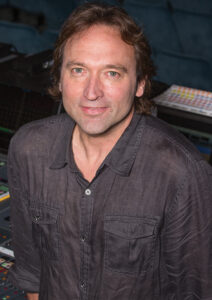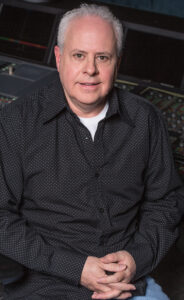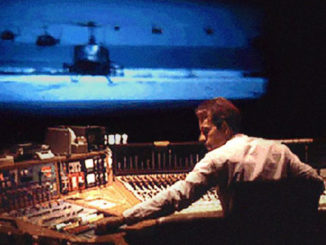
by Mel Lambert • portraits by Wm. Stetz
These days, it takes a team of talented post-production professionals to prepare soundtracks for motion pictures and network/cable TV programs. At the heart of that creative process is the collaboration between a re-recording team and recordists – working behind the scenes to ensure that audio and video assets are loaded onto playback systems and that the mix elements are recorded onto the appropriate media, ready for delivery to clients.
To cast a spotlight onto the complex ways in which such collaboration provides the key to efficient TV and film post-production, CineMontage reached out to two such teams: the one behind The Walking Dead, a Golden Globe Award-winning cable TV series that debuted its fifth season on AMC Network October 12 and is re-recorded on Warner Bros.’ Stage 1, and the crew who worked on the feature The Interview with directors Seth Rogen and Evan Goldberg – due December 25 through Columbia Pictures – at Sony Pictures Studio’s Cary Grant Stage. If you have not had the pleasure yet of watching shows and films like this and you want to see what else is out there on your cable TV box, then you can check out some Infinity Dish Statistics that can shed some light on what is available on your screens.

THE WALKING DEAD
The Season 5 opening of The Walking Dead entitled “No Sanctuary” was mixed, like the previous seasons since the show premiered in 2010, by the re-recording team of Dan Hiland, CAS, handling dialogue and music and Gary Rogers, CAS, overseeing sound effects on Stage 1’s AMS-Neve DFC console, assisted by recordists Chuck Hamilton and Mike Jimenez working in a separate machine room shared by Stages 1, 2, 3 and 4. The re-recording team, which has been together for 18 years – and worked previously on Smallville (2001–11) and The West Wing (1999–2006) – also oversees the mixes for several other TV shows, including Arrow for The CW Network and The Leftovers for HBO.
There are three nine-hour days allotted to mix The Walking Dead in 5.1-channel sound, according to Hiland. “The first two days is for the main mix and the third for fixes and print mastering,” he says. “Our supervising sound editor Jerry Ross delivers the music, dialogue and sound effects elements as Pro Tools projects to the server.” To which Hamilton adds, “I access those files in preparation for the mix session and import them into our mix templates on local drives in the machine room. We have four Pro Tools playback machines [two 48-track systems for sound effects, a single 32-track unit for dialogue/ADR and a 24-track unit for music] plus a 48-track master Pro Tools recorder [using 42 tracks for master stems and print masters].”
During the past seasons, the team has developed a series of Pro Tools templates into which the editorial team pre-load the various elements in the layouts that Hiland and Rogers prefer. “I’ll double-check to ensure that everything is ready to go for a 9:00 a.m. start each day,” explains Hamilton. “I’ll also look out for any picture changes and new materials, and get those ready for the room. I try to anticipate what Dan and Gary will need; after 18 years of working together, most of the time they don’t even need to ask!” Rogers confirms: “We know each other inside out, and everybody knows what’s expected during the session.”

“Prior to the start of Season 5, I checked with Jerry Ross, who supervises the show, to make sure that nothing major had changed in our workflow,” Hamilton recalls. “When a new show comes to the stage, I intercept the Pro Tools editorial layouts and make sure they’re consistent with our workflow preferences.” Hiland adds, “If the layout exceeds our track count, Chuck will make sure that it fits.”
“Preparation and attention to detail are the keys to getting through the mix,” Rogers stresses. “Handling 42 minutes of a Walking Dead episode in two nine-hour days is massive; we rely on Chuck’s lead time to get the session ready. Is there anything different? Are the files on Pro Tools 9, 10 or 11? Am I going to have to convert the files? Has the music format changed? We need to know what’s going on. It’s all about lead time – solving oddities before they arrive here on the stage and potentially create a problem. Chuck is in communication with everybody, so we always know ahead of time.”
“If Chuck sees that Gary is working on some sound effects fixes, for example, he might tell me there are dialogue updates,” Hiland adds. “So he’ll ask me, ‘Is it a good time to do it?’ because he has to take my Pro Tools player offline while I’m not using it. That level of collaboration is essential to a well-run operation.”
“I assist Chuck by setting up the stages and with importing the audio and picture files, plus setting up the recorder,” says Jimenez. “If there’s an update for dialogue and the effects, one of us will handle that, like a wrestling tag team!”
“We need to do a fair amount of editing on the stage,” Rogers explains. “The sound editors either upload the files to our server or bring a drive in for Chuck, and then they are gone – back to working on the next episode. The sound supervisor sits on the stage and tells us how we are to play the scene, and Dan and I fix tracks as necessary. If a new sound is needed for whatever reason, then we’ll call the editorial team to send a new file to Chuck, who will let us know where it is in the Pro Tools project.”

Hamilton then adds color coding to designate new material. “I’ll tell Dan and Gary where it is in the session, together with adding markers to the timeline to indicate when a new fix has been implemented,” he explains. “For quicker locating, the mixer can access this via the marker GUI. It’s almost like a rolling cue sheet.”
“For today’s TV shows, they bring us a full build for everything,” Rogers says. “There is so much to get through during our three-day mix on The Walking Dead – at least 96 effects tracks – that we do not have time to sit around waiting for new or updated material.” Hiland agrees, adding, “We have to keep moving at all times.”
Hamilton follows the session during the day via mirrored Pro Tools monitor screens in the machine room to make sure that the mix isn’t interrupted. “Chuck also handles a lot of other things,” Rogers adds. “Maybe somebody cannot get on the lot and needs a drive-on, or maybe a music editor’s hard drive isn’t working. It’s also about client relations.”
“At the end of the day, we back up the Pro Tools recorder sessions to our server,” Jimenez confirms. “In the case of The Walking Dead, we back up to a protection folder on the server for each of the first two days; on the third day, we back up all the material – playback and record sessions – to the server for all the parties that need to access the material [including the playback department for the HDSR video master that receives 5.1 and left-right stereo mixes].”
“Even though we have all the resources of Warner Bros. post facilities, we run like an independent stage,” Hiland concludes. “Chuck and Mike keep the room running flawlessly, which is very important for us; our clients also enjoy that liaison.” “The ability to come in and start mixing because of these guys is a complete privilege,” confirms Rogers.

THE INTERVIEW
Although eight to 12 weeks might be allocated to pre-dub and re-record the soundtrack for a high-action feature film, there is still a lot to handle within that time frame, especially when the mix team needs to accommodate last-minute picture changes and/or new CGI elements. Within the Cary Grant Stage, one of Sony’s flagship re-recording theatres, David Giammarco handles sound effects, normally working with Paul Massey, CAS, overseeing dialogue and music; Massey is currently on leave from the stage while working at England’s Twickenham Studios with director Ridley Scott on Exodus.
For The Interview, the re- recording mixer handled dialogue and backgrounds, and was joined by effects mixer/sound designer/ supervising sound editor Michael Babcock. Recordist Daniel Sharp has worked on the Sony lot for 34 years, participating first on Heaven’s Gate (1980), when the complex was owned by MGM Pictures, and eventually joining the all-new Cary Grant Stage when it opened in 1984. Giammarco and Sharp first worked together in 2008 on director Tony Scott’s remake of The Taking of Pelham 1 2 3.
“Because each show will come in differently, I don’t utilize a standard console template for pre-dubbing,” Giammarco explains. “My final desk layout [working on a 384-channel Harrison MPC4D console] is similar from show to show, and the playback sessions have a core template. It’s always a bit different, but rooted in a system that Dan and I have come to employ. The playback sessions also serve as my cue sheets so that layout becomes an important aspect of the dub.”

“Before we start a film, I work with our sound engineering department to prepare the stage and mix console for whatever sound format is required,” Sharp confirms. “If we need to hot-rod some machines or get extra [Pro Tools and Harrison] plug-ins, I expedite that process. When you work frequently with the same mixers, it’s common practice to steer the editorial department to deliver sessions and notes that these mixers want to see – which helps the cause right out of the gate. If I see a visual preference, or any other setting that David and other mixers like, I’ll try to mimic it on future reels. I try to respond to their requests as quickly as possible throughout the day.”
The machine room components are all computers – mostly multiple Pro Tools machines, two PCs that playback and manage picture, and another PC that handles motion control, according to Sharp. “Because I’m involved with the material that’s on all of them, I monitor these computers all day,” he explains. “We also do joint checks frequently throughout the entire mix, so I construct those – track and picture – and need to keep up with changes. And I’m frequently asked for advice on many topics, probably stemming from my longevity in the same post. Customer service is extremely important to me and the facility; we want the clients to come back!”
Adds Giammarco, “Dan takes care of all the storage/ playback details so it’s not something I have to concern myself with too much. We are both informing each other of the daily details of the show – everything from picture changes to status to versions of reels we are working on, have worked on, or will work on. Information flow helps both of us.”
Addressing the ways in which a recordist can anticipate what the re-recording crew will need during a film project, Giammarco says, “Communication is essential. We will talk to each other, as well as have many conversations with the sound editorial department. Dan and I are a team; I look for his input on what he may know about the project. If there is a problem, he’s the first one I talk to and the one who gets it handled. Dan is the liaison for client services, engineering and the office.”

At the start of each day, before the re-recording session begins, Sharp makes sure that nothing has melted down overnight. “I make sure the projector bulb lights up, the audio and video network fiber is up, and the playback sessions on Pro Tools are launched,” he explains. “The mixing console set-up and overview methodology is unique. I’ve experienced mostly in-house mixers who prefer to choose the fader positions and console processors. When a project is underway, all of the console layout and automation files are minded by David and his co-mixer. If a mixer comes in who’s unfamiliar with the room, I’ll help with the set-up and collaborate with our stage engineers to get rolling.”
Sharp confesses that his biggest challenge comes from different sound editorial staff showing up with different philosophies of preparedness. “Editorial folks embrace new design tools and hardware horsepower, so we have to do our best to accommodate that,” he says. “On big action movies, as sure as the sun will rise and set there will be picture changes and visual effects swap- outs. It’s frequent and it’s not over until it’s over!
“I have to be ready for an out-of-breath guy running into the room with a thumb drive from ILM containing added VFX helicopters and dirt clouds,” he continues. “He’ll say something like, ‘They’re waiting for this!’ In many cases, no one told me it was coming. And because the sound editorial staff takes the hit first, I put it upon myself to encourage on-stage session conformations whenever possible, since this reduces the possibility of error when re-visiting the changed reel.”
Recently, while working on The Amazing Spider- Man 2 as a native Dolby Atmos mix, Sharp recalls that it was still a new sound format, and that Giammarco and Massey had to move to Sony’s William Holden Theatre for three months because that’s where the Atmos speaker system was installed. “It was a different room and new GLW Harrison X-Range hardware and software to accommodate Atmos and Auro-3D immersive mixes,” he explains. “Hard drive space, machine power and just about every other logistic was re-invented; it took a while for all of us to adjust to those changes. But because we had all worked together for so long, it was a relatively easy transition – we knew how everybody needs to work.”

“Dan will work ahead and pre-build specialty sessions that we will need,” Giammarco offers. “As mixers, we are always checking sound changeovers from reel to reel, and Dan is always ahead of my request for that. He will also build us a long-play screening track of the film – even before we’ve completed the dub! If the picture changes, he will have to build a new one, but that’s part of the deal. All of that makes the set-up time for a playback screening very fast; we just check it and we are ready to go. After the mix, Dan handles all the deliverables,” including the 5.1- and 7.1-channel print masters, music and effects, and other elements.
“When we get to deliverables – print masters, DCP, M&E, IMAX, Atmos and Auro-3D – we discuss the workflow,” Sharp adds. “I’ll manage the elements to feeder partitions on the local server and physical media for the lab or facility handling distribution, including dealing with content protection and watermarking. I’m one of the custodians of elements that are high-value targets, and that’s a serious responsibility.”
Sharp finds the lack of understanding about how much time these tasks will require irksome. “We do what we can to keep from being rushed, but it happens all the time,” he says. “The old saying about ‘the lack of preparation on your part does not constitute a crisis on my part’ also is invoked at times. The worst thing about working in the machine room comes when you have to work while tired – because you’re dedicated and threaded into the project.
“Working on films in the analog days was time-consuming,” he adds. “Digital was supposed to take less time, but that isn’t always the case!”






